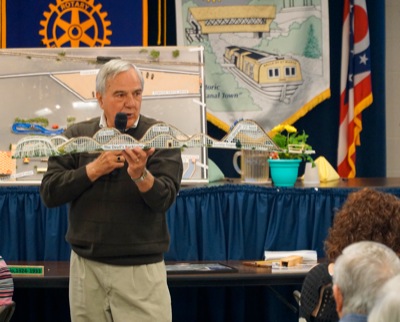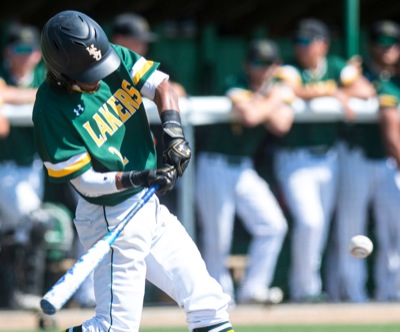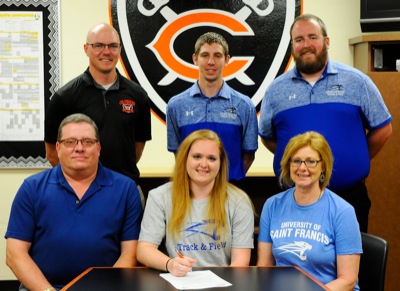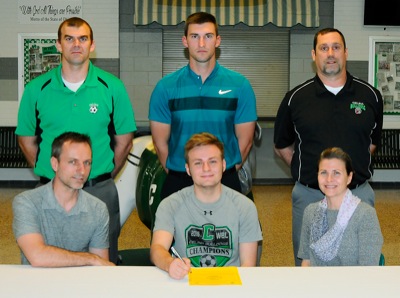Thursday, April 27th, 2017
Retired St. Marys teacher brings old lake park coaster back to life
By Ed Gebert

Photo by Ed Gebert/The Daily Standard
Retired St. Marys teacher and coach Denny Long holds the model he made of The Devil's Backbone, the wooden roller coaster from the former Gordon State Amusement Park. The park was a popular attraction on the shores of Grand Lake's east end from 1924-1933. Long spoke on Wednesday to St. Marys Rotary Club members about the coaster and the defunct park.
ST. MARYS - Denny Long is a roller coaster lover.
The former teacher and football coach from St. Marys has ridden 637 different coasters in eight different countries over the years. However, when addressing the St. Marys Rotary Club on Wednesday, he spent most of his time discussing a coaster he's never ridden nor even seen: The Devil's Backbone. The coaster was the star attraction at the former Gordon State Amusement Park, which sat on the shores of Grand Lake in the Villa Nova area of St. Marys during the 1920s and 1930s.
Visitors would have to walk through the Devil's Backbone to enter the park, Long said.
"Isn't that great? You'd go through the roller coaster to get to the park." he said.
And this was no rinky-dink ride, he noted.
"If this coaster were alive and running today, it would still be the fourth-steepest wooden roller coaster in the world," he said.
From its starting station, the ride scaled a large hill before descending down at a 70-degree angle. A couple of smaller hills followed before riders came around to head back to the station.
"What makes the coaster special is the turnaround," he said. "Most out-and-backs, go out, like the Blue Streak (at Cedar Point), go out, make a nice U-turn, and then come on back. Not this one. This coaster, for the turnaround, first makes an S-turn, then goes into a big flying fan curve, then it dips back to ground level. Then it makes a second big, wide fan turn. Then it makes a sharp S-turn, and only then, comes bunny-hopping back to the station."
Long seemed to see the ride clearly in his mind as he described it even though it has been gone since 1933. He said the turnaround has never been duplicated and never will be.
"It had to be just wild," he said.
Long's expertise on the ride stems from his research into the old amusement park. He has studied the scant mentions of the ride from old newspapers and journals, and has constructed a model of the entire park, which he displayed during his presentation, after poring over the few extant photographs that show parts of the former tourist attraction. He compared the Devil's Backbone to the Blue Streak, saying they are very similar.
Long recounted an incident in which a man fell off the top of the Devil's Backbone's biggest hill.
"According to newspaper reports, the doctor that examined him was quoted as saying, 'If he had been sober, it would have killed him!' " Long said, laughing.
The Villa Nova area offers only two small hints the park ever existed, he said. Two roads in the area are named Parkway Drive and Gordon State Drive.
"It's not labeled. It's not marked. It should be," he said.
The shoreline of Grand Lake has changed, and St. Marys itself is different, Long noted.
"In the middle where those two roads joined, there's nothing but green grass and a bike path," he said. "But at one time that was the parking lot for Gordon State Amusement Park."
The park opened in 1924, just after World War I when people were excited for local attractions. Long said the park was never a money-maker. In fact, it probably lost money every year it was open. Then when the Great Depression hit and money got even tighter, the park didn't stand a chance. Events in 1932 and 1933 sealed the park's fate.
"First of all, the dance hall burned to the ground. Nobody knows why," he said. "That also charred the roller coaster because it was close by. Then that spring, a tornado came across the lake and knocked down part of the roller coaster, and that was about the end."
The Devil's Backbone was sold off for scrap wood. The other rides, like The Old Mill water ride, the miniature railroad and the Custer Cars - an early version of go-karts - also were sold off, and the property was donated back to the state by owner Robert Gordon, Long said. The state still owns the mostly swampy land today. It wasn't useful for housing as much of the rest of Gordon's land holdings in Villa Nova were.





